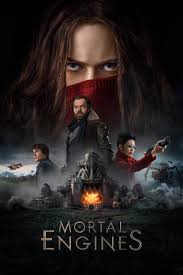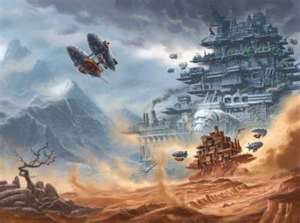The movie version of Mortal Engines opens this weekend. Here’s our original review of the series, originally published in January 2011.
The Hungry Cities Chronicles, by Philip Reeve: Mortal Engines (2001), Predator’s Gold (2003), Infernal Devices (2005), A Darkling Plain (2006). Harper Collins. Age/interest level: 14-up.
If I were idly browsing shelves, I would pass these books right by. The old-style sci-fi jackets picturing flying machines skimming over alien landscapes, not to mention the genre (dystopia—not again!!), would have no appeal were it not that I had been asked what I thought of them. So I checked out a copy of Mortal Engines . . .
It ws a dark, blustery day in spring, and the city of London was chasing a small mining town across the dried-up bed of the old North Sea. In the distant, dysfunctional future, centuries after an apparent nuclear holocaust called the Sixty Minute War, communities have piled up their treasure and tradition and plow on massive tractor treads over the blasted wastes known as the great Hunting Ground—what’s left of Europe. It’s a town-eat-town world, where bigger cities prey on the smaller ones and predator suburbs lurk on the fringes. All are equipped with jaws that open wide to swallow small prizes whole or rip the larger ones apart piece by piece. If they survive the attack, inhabitants of the unfortunate prey become galley slaves and all their metal and artifacts become part of the conqueror’s resources. The system is called Municipal Darwinism, and it works well enough for the big boys of former Europe. But the former Asia has become headquarters of the Anti-Traction league, a band of free agents and aviators and saboteurs protected by the Shield Wall.
As the story begins, London is on the move, and rumor has it she’s headed for the Shield Wall with a plan—maybe even a secret weapon—to batter it down and break into new hunting grounds. Sounds grim, and if the author were only interested in the mechanics of this weird world, it would be grim—and worse, boring. But he seems to be more interested in people. In fact, it’s no stretch to say that the Hungry Cities Quartet is primarily a love story.
Of course you can’t fill four volumes with a love story, unless your name is Stephanie Meyers and you had a dream about vampires. Chases, warfare, treachery, alien societies, last stands, destruction, and death stampede across the narrative—action so intense at times the reader may feel like a hungry brain, chomping through page after page. Reeve’s novels have been described as Dickinsian, and the abundance of colorful characters with quirky names and their coincidental meetings over a large landscape do call the master novelist to mind. But Reeve also works in trenchant, and often hilarious, observations on history, art, politics, and the gods—including one who “must know what it meant to be frightened, and to suffer, and to die.”
Tom Natsworthy, a 15-year-old apprentice historian aboard the city of London—and an orphan, no less—possesses the wide-eyed guilelessness of an Oliver Twist. Tom’s hero is Thaddeus Valentine, head historian, researcher, and adventurer, whose daughter Katherine is the object of Tom’s first crush. As London charges across the North Sea, the city takes aboard a motley group of scavengers, one of whom is a girl with a horribly scarred face who identifies herself as Hester Shaw—just before drawing a sword and attacking Valentine. She fails to kill him, but escapes through the bowels of the city. Tom follows, intending to capture her, but in surprise twist he finds himself abandoned with her on the blasted earth.
Hester is not only ugly; she’s bitter, vindictive and harsh, with some reason. Cast out on the wilds after her mother was murdered, she was rescued and raised by a Stalker—a so-called Resurrected Man killed in action and brought back to robotic life to function as a war machine for the Anti-Traction League. He has come to “love” Hester as a daughter, and lives (if you can call it that) for the day when she will die, because then he can see her engineered into a stalker like himself. But Hester’s fate lies with Tom and over the course of their adventures they are drawn together. Inevitably? Hardly. Tom is easy to love: attractive, kind, perhaps a bit bland. Hester is not, and knows it, and in the grief of knowing it she sometimes lashes out: “I hate you! I hate you!” Hester was yelling. “Well, I care about you, whether you like it or not!” Tom screamed.
Their relationship is certain to be fraught. I can’t help thinking of the prophet Hosea and his wayward wife Gomer—or of Israel itself, abandoned in a ditch, lifted up by the Lord, loved and honored but chronically unfaithful (Ezek. 16). In Volume 3 Hester learns that she is the daughter of her worst enemy: the evil, she believes, is hereditary. So it is with us: “In Adam’s fall we sinned all.” But Tom, though frustrated and even infuriated at times, never stops loving her—not for what she is, but for who he is, out of his own generous heart. He calls things that are not as though they were (Rom. 4:17): to him, she is strong and brave and beautiful.
The pacing is brisk throughout, the characters indelible and sympathetic, and the body count is alarmingly high, especially in the first book, where so many characters bite the dust there are almost none left for volume two. Life is brutal and short:
Peavey pulled out a gun and shot him dead. “I said, give the gentleman back his COAT!” he shouted at the startled-looking corpse, and the others hurried to pull the coat off and give it back to Tom.
But the author comes through with more characters—and besides, in this world, dead doesn’t always mean gone. Of the strange fate of Anna Fang, the audacious career of N. B. Pennyroyal (a farcical version of Valentine), the underwater kingdom of Uncle and his “vicious and sentimental, greedy and generous” Lost Boys, the evolution of Dr. Zero (who created Stalkers without qualm until forced to resurrect her own brother), the rise of the eco-terrorist Green Storm, with their “shiny smug expressions and hatred of humanity,” of the unexpected rebirth of new London from the wreck of the old—of all this, there’s no room to tell, though I’d love to. Because I got hooked. I’m a fan of good writing, and Reeve is a great writer (the English get all the good lines, but why not—it’s their language). The last four pages are stunning. But I’m also a fan of creation, and its summit, a being in God’s own image. The author may have no god but history, but to those who know history is going somewhere, the Hungry Cities may be a good way to fill a few winter nights. Warning: the violence is not graphic but it’s fairly constant, and often intense.
- Worldview/moral value: 3.5
- Literary value: 5
A similarly clanky, but less thoughtful, series for young adults is Scott Westerfield’s Leviathan. And another English fantasy writer I admire is Jonathan Stroud, author of the Bartimaeus series.
Stay Up to Date!
Get the information you need to make wise choices about books for your children and teens.
Our weekly newsletter includes our latest reviews, related links from around the web, a featured book list, book trivia, and more. We never sell your information. You may unsubscribe at any time.
Support our writers and help keep Redeemed Reader ad-free by joining the Redeemed Reader Fellowship.
Stay Up to Date!
Get the information you need to make wise choices about books for your children and teens.
Our weekly newsletter includes our latest reviews, related links from around the web, a featured book list, book trivia, and more. We never sell your information. You may unsubscribe at any time.
We'd love to hear from you!
Our comments are now limited to our members (both Silver and Golden Key). Members, you just need to log in with your normal log-in credentials!
Not a member yet? You can join the Silver Key ($2.99/month) for a free 2-week trial. Cancel at any time. Find out more about membership here.
7 Comments
Leave a Comment
You must be logged in to post a comment.




The only Reeve book I’ve read is Here Lies Arthur, which I enjoyed. But I would have looked over these for all the reasons you mentioned. You have convinced me they may be worth a shot.
The first book is the weakest, in my opinion. I let a few months go by before moving on to the second, but after that I couldn’t stop. Not for everybody, but worth a shot, definitely.
Thank you for this great review, Janie. I appreciate your perspective on the overall value, as I tend to get snagged on isolated elements, like the resurrected warriors–yet, as you say, the story is really about love: loyal and lasting, self-sacrifical, not trite in its treatment. My 16-yr-old really likes this series, and enjoys the clever ties of the world of the traction cities to our technology of today. The “seedies” brought a grin.
How wonderful to have linked to this from your World Mag article on Hunger Games. I read this book when on a sabbatical term at Cambridge and didn’t know it was going to be the first in a series. I agree with your aesthetic and theological evaluation. Wonderful and creative writing . . . thanks.
Steven, Thanks for chiming in! Philip Reeve has written a fantasy series for younger children I plan to review later.
Readers should be wary of the prequel trilogy, Fever Crumb, about the time London is first made into a traction city. The trilogy ultimately shows what happens when you try to suppress emotions, including love, and try to let reason rule. However, in the second book, it mentions a Christian nation several times that kills anyone who tries to use technology. And by the third book, the main character Fever Crumb realizes she is in love with another girl and daydreams about her fairly often.
Thanks for this, Kat. I had heard of Fever Crumb, but had not read it (only so many hours in the day). I have read enough other books by Philip Reeve to know I can’t recommend him without reservation. I do heartily recommend his Larklight series though: great fun, and the (historically based) Christian references are at least not negative.